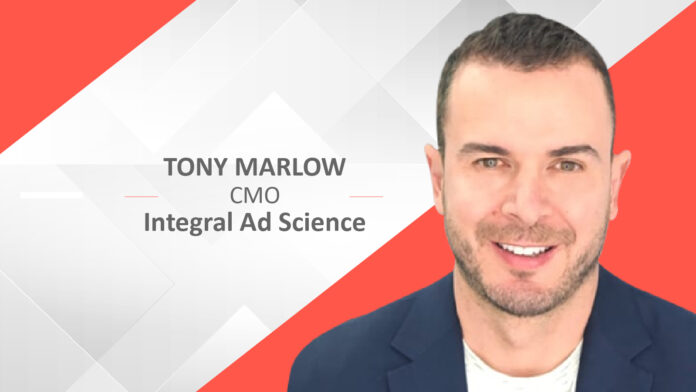“What is most interesting about social media in general is that it represents a fantastic opportunity for brands to connect with their audiences while also maintaining a solid understanding of a person’s potential mindset in a given moment in time due to the contextual cues available” says, Tony Marlow, CMO, Integral Ad Science (IAS), in an exclusive interview with TalkCMO.
TCMO Bureau: In what ways can social media in digital marketing help generate leads?
Tony Marlow: The modern buyer journey intrinsically includes numerous social media touchpoints. The proportion of time people spend across almost all of these channels has consistently been growing. What is most interesting about social media in general is that it represents a fantastic opportunity for brands to connect with their audiences while also maintaining a solid understanding of a person’s potential mindset in a given moment in time due to the contextual cues available.
We know that digital ads that are placed in certain contexts can be more memorable. According to recent research from IAS, seven-in-ten (70%) consumers are more likely to remember an ad when it appears next to contextually relevant content online. To ensure marketers can translate these insights into business outcomes, it is paramount that the digital advertising industry adopt innovative methods such as contextual targeting to keep pace and effectively connect with consumers.
Read More: Can Smart data Analysis help detect new methods of growth?
TCMO Bureau: Will concerns about the transparency in media quality metrics impact social ad spend?
Tony Marlow: There is no denying the power of social platforms. There is a very real opportunity for this to become even more impactful through increased transparency into media quality and associated metrics across these environments.
The IAS Industry Pulse Report surveyed advertising professionals on the key trends that will dominate 2021 and found that most are likely to adjust social media ad spend if they feel they have insufficient media quality metrics. Advertising professionals want maximum transparency regarding digital media quality in areas such as brand risk and viewability.
Social platforms provide advertisers with an extraordinary level of audience reach and engagement. The holy trinity is achieving reach, engagement, and high-quality media placements. So it is not surprising that almost half of the industry sees social media as a high priority in their 2021 media strategy.
TCMO Bureau: In what ways can marketers measure ROI with new media advertising opportunities?
Tony Marlow: When it comes to marketing ROI, one critical component is monitoring advertising media quality.
For instance, if ads are rendering below the page fold, they cannot even be seen and therefore cannot impact their intended audience. The same is true if ads are served to bots rather than humans. If ads turn up in unsafe environments, that can be even worse because it can impact a brand negatively.
Essentially, allowing low media quality within a campaign means advertisers are paying for impressions that cannot possibly connect with a person. In the worst-case scenario, it could negatively impact a brand’s perception. So the easiest and most effective way to significantly increase ROI is to optimize campaigns to the highest quality impressions.
TCMO Bureau: Online ad fraud is one of the biggest issues faced by the online ad industry. What are some of the most effective approaches to combating ad fraud?
Tony Marlow: Increased adoption and innovation pushes platforms forward but also creates challenges around ad fraud. A big trend that we’re seeing is fraudsters becoming more sophisticated and using Artificial Intelligence (AI) and Machine Learning (ML) techniques to perpetrate fraud. Such fraudulent bot activity strives to mimic human behavior, consuming digital content such as watching online videos, and engaging with ads. As a result, more accurate and sophisticated tools for detection are needed.
Read More: Leveraging Technology to Overcome Challenges in Client Engagement
In the modern fraud landscape, it takes a bot to catch a bot. So using an ML-driven approach that dynamically learns about previously unknown threats is critical. Marketers need to make sure that their fraud mitigation solution has these capabilities because if they are solely using providers that rely on ‘deterministic’ fraud mitigation, then they are depending on human rules to try to stop a highly scalable machine-driven threat.
A multilayer approach utilizing the best of both worlds – both human rules and ML – results in effective detection and mitigation of ad fraud. Partnering with digital ad verification companies that provide the latest technologies in combating fraud is paramount to ensure ad spend is invested to reach real people.
Tony Marlow is the Chief Marketing Officer for Integral Ad Science, based in New York. He is an insights-driven executive and leads all aspects of corporate marketing strategy, brand development, and communications for the company.
Before joining IAS in 2019, he was the CMO for the big data company Data Axle, and prior to that, he was the Global Head and Vice President of B2B Marketing for Yahoo – overseeing all B2B Marketing, Marketing Strategy, Product Marketing, Sales Learning, and Sales Insights.
Tony previously led the Custom Research division for Nielsen Online APAC. He is a media/marketing expert with special interest not only in data and digital media, but specifically in helping brands be innovative to make deeper and more meaningful connections with people.







